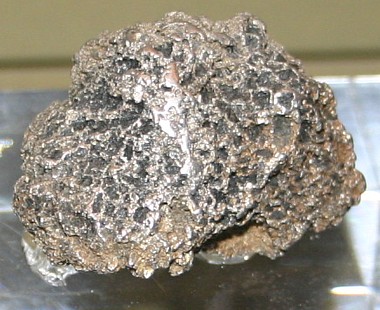
| PLATINUM MINERAL FACTS |  |
|
| The Gem and Mineral Collector's Photo Gallery by Nevada Outback |
|
. Platinum Mineral Facts: Chemical Formula: Pt
Colors:
Steel-gray with a bright metallic shine.
Hardness:
4 to 4.5 Density: 14 to 19 depending on impurities Cleavage: None
Crystallography: Isometric Luster:. Bright metallic luster. Optics: (Refractive Index): Opaque |
Platinum Nugget, California |
|
Identification and Diagnostics
Occurrence,
Localities and Origins: It occurs also in the stream sands, as placer deposits, where it has been preserved on account of its great weight and hardness. Platinum alluvial deposits are associated with the rarer metals of the Platinum Group, gold, iron-nickel alloys, chromite, etc. Its original source is probably usually in peridotite rocks or the serpentine rocks resulting from their metamorphism. It occurs so sparingly disseminated through such rocks, however, that it is only after their disintegration and the subsequent concentration of the platinum in the resulting sands that workable deposits of the metal are formed. Placer deposits of platinum are therefore to be looked for in the vicinity of masses of such peridotite rocks. Historically, before the hard rock supplies came on line, nearly the entire world's supply of platinum came from the Ural Mountains in Russia. The central and northern end of this range has large masses of altered peridotite rocks, and in the sands of the streams descending from it, chiefly on the eastern slope in Siberia, platinum is found in considerable quantity. The chief districts are Nizhni Tagilsk, Bissersk and Goroblagodat, and farther to the north, Bogoslowsk. Platinum was first discovered in Colombia, South America, where it received its name platina from plata (silver). It is to be found there in two districts near the Pacific coast. The chief district covers the greater part of the intendencia of Choco, while the second, that of Barbacoas, is in the department of Cauca. The platinum occurs here with gold in placer deposits, and, while the fields are not largely productive at present, they may become so. The only platinum found in the United States came from the gold placer deposits of Alaska, Oregon and California. Return to the Mineral Collectors Information Page |
Natural Platinum Crystals |
|
 |
||
Please note that the author, Chris Ralph, retains all copyrights to this entire document and it may not be reproduced, quoted or copied without permission.

NEVADA OUTBACK GEMS TURQUOISE AND JEWELRY